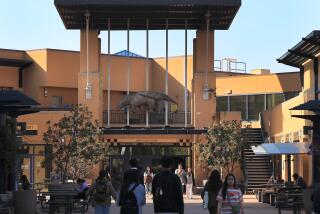UC San Diego reaching out to Native American youths
UC San Diego has stepped up efforts to promote college culture among Native Americans under a new partnership with the Sycuan and Viejas tribes as the university seeks to boost enrollment in underrepresented communities.
Launched this year, UCSD Extension’s Global Environmental Leadership and Sustainability Program will give middle and high school students the opportunity to attend summer college-prep courses at UC San Diego and at universities in Arizona, New Mexico, Hawaii and Washington, D.C.
Jennifer Medeiros of the Sycuan Teen Center said the initiative will strengthen the ongoing work of both tribes to demystify college for Native American youth.
“We are trying to increase the exposure that Native American students have to different college experiences so that they can really see themselves in college,” Medeiros said. “College should not be a completely foreign experience for them.”
Native Americans make up about 1.3% of the population in San Diego County and 1.7% in California. They accounted for 0.4%, or 109 students, of the UC San Diego undergraduate population last fall, a slight increase from 92 students in 2009.
High school students from Viejas and Sycuan have been preparing since February for weeklong courses at Biosphere 2 in Oracle, Ariz., as well as in Los Alamos, N.M.; Hilo and Kona, Hawaii; and Washington, D.C. Students will also participate in Academic Connections, a three-week residential program at UC San Diego.
Rayanna Sandoval, an incoming senior at Steel Canyon High School and a resident of the Sycuan reservation, will study in Hawaii this summer.
“My parents and grandparents weren’t given the opportunities that I have been given,” said Rayanna, 17. “I do feel the pressure to satisfy their hopes and dreams that they have for me. I hope the experience puts me one step ahead of everyone else — Native American and non-Native American kids. I’m planning on going to a university after high school. That’s a big deal for my family. I want to apply what I learn to better my reservation — whether it’s in a medical facility or the casino.”
Several courses in the program incorporate the increasingly relevant STEAM subjects — science, technology, arts and math — most of which are ingrained in the history and culture of Native American culture.
For example, the Viejas and Sycuan students who visit Arizona this summer will study the effects of climate change through hands-on learning and experiments in the Biosphere 2 program.
“Sustainable agriculture, taking care of the earth, astronomy — these are all tied to the Native American culture,” Medeiros said. “This is also kind of about debunking the myth of the savage.”
The program is a collaboration with Sycuan Education Department and the Viejas Tribal Education Center.
Going forward, all high school students from the tribes will have the opportunity to attend one of the summer programs depending on their grade level. UC San Diego Extension will also offer preparation classes for the SAT and ACT college entrance exams.
A separate summer program affiliated with UCSD — Young Native Scholars — has similar goals. But in addition to an academic focus, students are immersed in their cultural heritage along with partaking in activities like surfing, kayaking and studying the stars.
Marc Chavez, a UCSD alumnus who founded the Young Scholars program, noted that “the campus sits on ancestral lands, on an old Kumeyaay village; the location is very important to us because it is a kind of coming back to the coast.”
The new program that involves the Sycuan and Viejas tribes is part of UC San Diego’s larger goal of reaching out to communities throughout the region in an effort for the campus to better reflect San Diego, according to Ed Abeyta, assistant dean for community engagement and director of pre-collegiate and career preparations for UC San Diego Extension.
Latinos and African Americans are underrepresented in the student population compared with the county population, and whites are also a smaller percentage of UCSD students than in the county. Asians are a much higher percentage at UCSD compared with the county.
“UCSD Extension has a mission to connect the campus to the community,” Abeyta said. “We want to engage every underserved community in the region to strengthen UC San Diego and the community.”
Brenda Montero, education manager at the Viejas Tribal Education Center, said forging a college culture among Native American students is complicated. Native American youth have often been influenced by their relatives who had negative experiences in the American Indian boarding schools they were forced to attend, she said.
“There is still some negativity about education,” Montero said. “Some of our grandparents have been in the boarding schools and had horrible experiences.”
Beginning in 1860, Native American children were forced to attend boarding and day schools off their reservations in an effort to assimilate them to Western ways. The schools were known for harsh discipline, the spread of disease and strict rules that promoted Western culture over Native American traditions. The Indian Child Welfare Act, passed in 1978, allowed Native American parents to reject the schools.
The Viejas Tribal Education Center serves 130 students from kindergarten to 12th grade, and the Sycuan Tribal Education Center Serves 75 students in those same grades.
More to Read
Start your day right
Sign up for Essential California for news, features and recommendations from the L.A. Times and beyond in your inbox six days a week.
You may occasionally receive promotional content from the Los Angeles Times.






